|
Annual
Report - 2018
REPORT OF THE NEW YORK STATE AVIAN RECORDS COMMITTEE
FOR 2018
The New York State Avian Records Committee (hereafter “NYSARC” or the “Committee”) evaluated 80 submissions involving 59 occurrences of New York State review species from 2018 and an additional one from 1984. Reports were received from across the state, with 25 of the 62 counties and the pelagic zone represented. The number of reports accompanied by photographs remains high and naturally benefits the value of the archive. The Committee wishes to remind readers that reports submitted to listservs, local bird clubs, rare bird alerts (RBAs) and even the Kingbird Regional Editors are not necessarily passed along to NYSARC. Doing so, therefore, remains the responsibility of the observer(s). The best way to ensure a rarity is reviewed by NYSARC is to submit a formal report to the Committee, which would include written details and possibly photographs or audio recordings. Submitting an acceptable report to eBird also works, although NYSARC review of eBird reports may lag slightly behind reviews of formal submissions. As is well-known by now, the use of the Internet and mobile phones has had a very positive impact on the timely dissemination of rare bird sightings and has made it easier for birders to locate rarities found by others. The Committee has always held that receipt of multiple independent reports provides a much fuller documentation of the sighting and can in some cases increase the likelihood of acceptance. We therefore urge ALL observers, not just the finder, to submit written reports and/or photographs. The names of the 52 contributors that submitted materials (written reports, photographs, video and audio recordings, and sketches) are listed alongside accepted reports and again at the end of this document. Where possible, the name(s) of the original finder(s) is (are) included in the narratives. Production of this Annual Report is a team effort. In addition to the contributors referenced above, some Kingbird Regional Editors and eBird reviewers have helped observers to prepare and submit documentation.
HOW TO SUBMIT REPORTS
Advice on how to prepare and submit a report is provided on the NYSARC pages within the NYSOA web site: https://nybirds.org/NYSARC/index.htm. Although it may go without saying that photographs and/or audio recordings of the reported bird(s) can be vitally important to getting a record accepted by the Committee, it cannot be emphasized enough that a thorough written description of the bird(s) and the circumstances of the observation, as well as other pertinent details, can also propel a record to acceptance. Unfortunately, eBird reports are frequently very short on details and when those reports also lack hard evidence, such as photos or audio recordings, it becomes difficult for the Committee to accept them.
This highlights an important distinction between NYSARC and eBird. Some eBird reports are accepted by eBird reviewers in large part because the observer is considered experienced. While NYSARC may consider the observer’s experience, we want accepted records to have archived documentation that can be reviewed by anyone in the future. As such, some reports from very experienced observers that have few or no substantial details and which were accepted by eBird reviewers, will not be accepted by NYSARC. Also on the NYSARC pages is a list of species requested for review by NYSARC (The Review List) as well as illustrated copies of previous annual reports. The Committee is very grateful to Carena Pooth (NYSOA Web Master) for updating and continuously improving the NYSARC web site. An on-line reporting form allows observers to compose a written report and attach up to three digital image files (maximum size 7 MB per photo). Documentation (written reports, photographs, audio recordings) and any other correspondence for the Committee can also be sent via email to the NYSARC Secretary, Gary Chapin, at: nysarc44@nybirds.org. As a last resort, you can also use regular mail to get your report to:
Gary Chapin, 125 Pine Springs Drive, Ticonderoga, NY 12883.
HIGHLIGHTS
For the first year since 2009, there were no new additions to the state list in 2018. The highlights included the third NYS record of Wood Sandpiper (Tringa glareola), only the second records of Trindade Petrel (Pterodroma arminjoniana) and Roseate Spoonbill (Platalea ajaja), the fourth of Green-tailed Towhee (Pipilo chlorurus), and the fourth for Kirtland’s Warbler (Setophaga kirtlandii).
COMMITTEE NEWS
The 2018 annual meeting was held via Skype on 21 Mar 2020, six months after the 2017 annual meeting. Note that the annual meeting year refers to the latest reports reviewed at that meeting. After the first round of review, 12 formal submissions were left for additional discussion and voting. Three of those were settled using email discussion, prior to the meeting, and the remaining nine were completed either during the meeting or sometime later, after obtaining additional information and expert opinions.
Several potential changes to the review list were discussed at the 2018 annual meeting. The following changes were decided upon at the meeting:
change “Greenland” Greater White-fronted Goose to upstate review only (U);
change “Western” Greater White-fronted Goose to downstate review only (D);
remove “Eurasian” Green-winged Teal from the review list;
remove Summer Tanager from the review list.
Shortly after the 2018 annual meeting, the Committee decided to change Arctic Tern to upstate review only (U). This species presents significant identification problems for most birders, which was the main reason that it has been kept on the review list for downstate areas and the pelagic zone. The only area where the Committee did not request documentation for this species was Cupsogue County Park in Suffolk County, where there has been an established pattern of occurrence for many years. However, over the past decade or so, more informed birders have documented the species occurring with some regularity on other outer beaches of Long Island as well. This enabled the Committee to remove Arctic Tern from the downstate and pelagic zone review lists.
2018 Reports Accepted
Black-bellied Whistling-Duck (Dendrocygnaautumnalis)
2018-22-A One, Calvert Vaux Park, Kings, 16 May (Joshua Malbin, ph J. Malbin). eBird 16 May
2018-60-A Two, Nissequogue River State Park, Suffolk, 23 Jun (Shaibal S. Mitra). eBird 23-28, 30 Jun, 1-5, 7-14 Jul
Alex Wilson found the Black-bellied Whistling Duck at Calvert Vaux Park, associating with Brant, in Brooklyn. The duck was apparently viewed on just this one day and only by a few observers. Joshua Malbin documented the record for NYSARC. The two birds at Nissequogue River SP were found by Jim Lafferty and stayed for three weeks.
Pink-footed Goose (Anser brachyrhynchus)
2018-10-A One, Fort Miller, Washington, 21 Mar (Scott L. Varney)
2018-61-A One, Montauk Downs Golf Course, Suffolk, 4 Feb (Shaibal S. Mitra). eBird 16-18 Dec 2017, 11, 13-15, 19, 21-23, 28, 29 Jan, 4, 6, 8, 10-14, 17-19, 22, 24, 27 Feb, 1,
3, 4, 11 Mar 2018
The Fort Miller Pink-footed Goose was a first record for Washington County. It was found and documented by Scott Varney, continuing a trend of increasing records in the eastern portion of the state. The Montauk goose was apparently first found on 26 Nov 2017 by Bruce Horwith and stayed through most of the winter.
“Black” Brant (Branta bernicla nigricans)
2018-46-A One, Fort Tilden, Queens, 19 Nov (Steve Nanz, ph S. Nanz)
This Brant, of the western North American subspecies, was found and nicely photographed by Steve Nanz. Although a few “Black” Brant have been found in New York in the past, it seems that this may be the first documented juvenile. Due to the close similarity between juvenile “Dark-bellied” Brant (B. b. bernicla) and “Black” Brant, the Committee studied photographs of the two forms, had a lengthy discussion about this bird, and solicited input from various goose experts. The reduced contrast between the neck sock and the breast shown by the Fort Tilden bird, particularly in the center of the breast, seemed to be a consistent difference from “Dark-bellied” Brant. Several Committee members noted this distinction as did some of the outside experts who responded to NYSARC’s request for opinions. After further discussion, the record was unanimously accepted by the Committee.
White-winged Dove (Zenaida asiatica)
2018-47-A One, Cupsogue Beach County Park, Suffolk, 30 May (Eric Zawatski, ph E. Zawatski). eBird 30 May
Eric Zawatski and Shawn Sullivan discovered this White-winged Dove at Cupsogue Beach, providing yet another briefly seen record of this southern species for the south shore of Long Island.
Rufous Hummingbird (Selasphorus rufus)
2018-45-A One, Rosendale, Ulster, 11 Nov (Robert P. Yunick, ph Annie Mardiney) This hatching-year female Rufous Hummingbird was reported to be at the feeding station of Rob Johnson in Kinderhook, Columbia County, on 8-10 Nov. On 10 Nov it apparently had difficulty flying and Johnson was able to capture the bird by hand. It was brought to the facility of a licensed rehabilitator, Annie Mardiney, in Rosendale, Ulster County, where Bob Yunick was able to band the bird on 11 Nov. It was apparently doing well, flying and feeding inside of an enclosure at the time of his visit. Sadly, the bird passed away about two months later at the facility, even though it still seemed to be doing well (Annie Mardiney, pers. comm.). Unfortunately, the specimen was not preserved.
Although most of the Committee was in favor of accepting the record after the first round of review, two members wondered about the possibility that this could be a Broad-tailed Hummingbird (Selasphorus platycercus). After further discussion, the documentation was sent to Scott Weidensaul, Fred Bassett, and Sheri Williamson for their opinions. All three experts felt that the bird was, indeed, a Rufous Hummingbird. Williamson pointed out that there have been many examples of photographed birds in eBird that were identified as Broad- tailed Hummingbirds, which were actually Rufous, indicating that this is a difficult and widespread identification problem. In addition she pointed out that there is a broad hybrid zone between Rufous and Allen’s Hummingbirds which may explain a lot of birds with intermediate or inconsistent measurements.
Purple Gallinule (Porphyrio martinicus)
2018-3-A One, Manorville, Suffolk, 13-15 Jan (Paul Sweet, ph Virginia Fratti)
2018-4-A One, Southampton, Suffolk, 16 Jan (Paul Sweet, ph P. Sweet)
2018-41-A/B One, Prospect Park, Kings, 20 Oct (Tim Healy, Zach Schwartz-Weinstein, ph T. Healy, Z. Schwartz-Weinstein). eBird 19-24 Oct
2018-59-A One, Rockville Centre, Nassau, 14 Jan (Paul Sweet, ph P. Sweet)
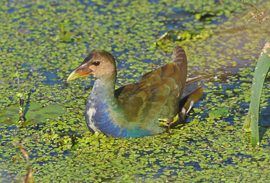 Purple Gallinule
photo
© Tim Healy
Purple Gallinule
photo
© Tim Healy
(click photo to enlarge)
The immature Purple Gallinule at Prospect Park in Brooklyn was found by Sean Sime and seen by many over the course of six days in October. Three other Purple Gallinules were found in a short span during mid January on Long Island. The Manorville bird was reportedly seen for three days before being brought to a wildlife rehabilitator, where it soon perished. Unfortunately, the specimen was discarded by the rehabilitator. The Southampton bird was found by Pamela Chadderton and her husband but was not well and died the same day. The specimen is now American Museum of Natural History (AMNH) Skin #844181. The Rockville Centre bird was brought in to Volunteers for Wildlife on 14 Jan
and died on 16 Jan. This specimen is now AMNH Skin #844182. All three of the Long Island records were submitted by Paul Sweet. One more Purple Gallinule was reported in New York during the winter spate of sightings, a bird found on 25 Jan in Lewis County, where it was captured and taken to a rehabilitator (eBird Feb 2021). NYSARC will review that report at a later date.
Ruff (Calidris pugnax)
2018-14-A Two, Port Byron, Cayuga, 12 Apr (Dominic Sherony, ph D. Sherony). eBird 10-12, 14, 16 Apr, 6 May (male); 12, 14, 15, 20 Apr (female)
2018-52-A One, Heckscher State Park, Suffolk, 22-23 May (Patricia Lindsay, ph P. Lindsay). eBird 22-24 May
In 2018, Montezuma NWR and vicinity was graced with the presence of two Ruffs, a male and a female-type. The black and chestnut male molted from transitional to spectacular full alternate plumage from 12 Apr to 6 May. The male was discovered by Gregg Dashnau and the female-type by Robert Spahn. A Ruff found in August of the same year in the same general area (eBird Feb 2021) will be reviewed by NYSARC at a later date. Pat Lindsay was birding one of her local shorebird patches, Heckscher SP, actually hoping to find a Ruff, when she came across another chestnut and black male, proving that following one’s instincts can indeed pay off. This marks the fourth occurrence of this species since 2013 at the two adjacent sites of Heckscher SP and Timber Point Golf Course.
Wood Sandpiper (Tringa glareola)
2018-51-A/B One, Great River, Suffolk, 16-17 Apr (Patricia Lindsay, Shaibal S. Mitra, ph P. Lindsay, S. Mitra). eBird 16-17 Apr
This mega rarity was discovered by Pat Lindsay at Timber Point Golf Course toward the end of a prolonged violent northeast storm. The identification was assisted by the efforts of Brent Bomkamp and Taylor Sturm, who tracked down the bird after it had flushed and disappeared, and Shai Mitra, who correctly suspected this species from the initial soft and distant photos Pat had managed.
This adult bird coming into alternate plumage constitutes only the third state record: an adult in basic plumage collected in Orleans Co. 10 Oct 1907 was the first, originally labeled a Solitary Sandpiper, then correctly identified in 1979 at the Museum of Vertebrate Zoology, University of California, Berkeley, Specimen #106848 (Dziadosz 1980, Burke 1998); then a juvenile was discovered at Rye, Westchester Co. 31 Oct 1990 by long-time Committee member Tom Burke (Burke 1991). Other records from eastern North America include one each from St. John’s, Newfoundland 11-14 Nov 1998 (Mactavish 1999), Delaware 5-15 May 2008 (Veit et al. 2008), Rhode Island 12*-30 Oct 2012 (Ellison et al. 2013), and New Jersey 20-22 Sep 2020 (Davis et al. 2021). There are also four from Bermuda (19 Oct 1981, 20 Apr 1983: Amos 1991; 11 May 1996, 12 Nov 2011:
eBird 2021) and no fewer than five from the small island of Barbados (16 Oct 1955, 15 Nov 1992, 5 Mar 1994, 25 Apr 1998, and 28 Nov 1998), at least one, and probably several of which overwintered (Buckley et al. 2009).
*The date of discovery is stated incorrectly as 13 Oct in the cited report. The bird was actually found and seen by many on 12 Oct (eBird; Mitra and Lindsay, pers. comm.).
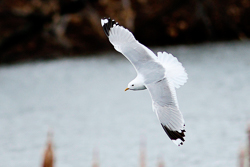 Common Gull
photo
© Ted Keyel
Common Gull
photo
© Ted Keyel
(click photo to enlarge)
Common Gull (Larus canus canus)
2018-13-A One, Collins Lake, Collins Park, Schenectady, 15 Apr (Ted Keyel, ph T. Keyel). eBird 15 Apr
This adult Common Gull (known as Mew Gull, at the time of the sighting) was nicely photographed by the observer, Ted Keyel. His photos included the all- important shots of the spread wing but the Committee was initially somewhat uncertain of the subspecies involved, with some wondering if it could be the Russian subspecies, heinei, a potentially very significant record, as it has never been recorded in North America. After further discussion and an opinion from the European gull expert, Peter Adriaens, the Committee voted unanimously to accept this as the nominate, European race, which has since been split from the North American form and is now known as Common Gull.
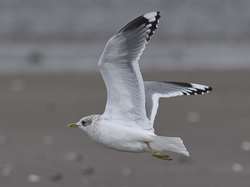 Short-billed Gull
photo
© Sean Sime
Short-billed Gull
photo
© Sean Sime
(click photo to enlarge)
Short-billed Gull (Larus canus brachyrhynchus)
2018-2-A One, Prospect Park, Kings, 20 Jan (Sean Sime, ph Michael Yuan, Geoffrey Jones). eBird 20 Jan
2018-5-A One, Floyd Bennett Field, Kings, 16 Mar (Sean Sime, ph S. Sime). eBird 16 Mar Sean Sime found these two adult gulls, both one-day-only sightings. His detailed description of the Prospect Park bird along with other observers’ diagnostic photos, as well as his excellent report and photos of the Floyd Bennett Field bird, enabled identification as the then-subspecific race of Mew Gull, brachyrhynchus, now awarded full species status as Short-billed Gull by the American Ornithological Society (Chesser et al. 2021). Sime commented that the Floyd Bennett Field bird could possibly have been the same individual as the Prospect Park bird, but without conclusive evidence the Committee decided it was prudent to treat these as separate records.
As noted in the 2017 NYSARC report (D’Anna et al. 2021), records of “Mew Gull” have been increasing in recent years, quite notably within New York City. For many years, the default assumption for the species in coastal areas was the nominate European Common Gull (L. c. canus). However, there are now multiple documented individuals of the North American Short-billed Gull (L. c. brachyrhynchus). As an interesting side note, and further evidence that the Brooklyn waterfront continues to be a magnet for these rare gulls, another Short- billed Gull, determined to be a different individual, was found earlier in the same week as the Prospect Park bird at the nearby Veterans Memorial Piers (eBird 2021). This report will be reviewed by NYSARC at a later date.
Slaty-backed Gull (Larus schistisagus)
2018-1-A/B One, Oswego, Oswego, 16 Jan (Kevin McGann, Bill Purcell, ph K. McGann, B. Purcell). eBird 16-19, 23, 25, 31 Jan, 6, 7, 16-19 Feb
David Wheeler found this adult Slaty-backed Gull on the Oswego River at Lock 6. Since the first New York record, in 1992 on the Niagara River, this Asian species has been recorded at least 16 times in the state. One cannot say that it was expected or even considered that plausible in 1992, as it was the first record in North America east of the Mississippi River (Brock 1998). Thus, this change in status for a species that does not breed in North America is truly remarkable.
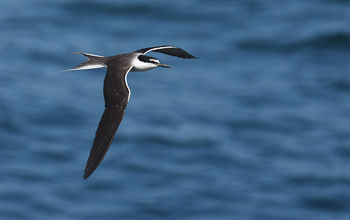 Bridled Tern
photo
© Sean Sime
Bridled Tern
photo
© Sean Sime
(click photo to enlarge)
Bridled Tern (Onychoprion anaethetus)
2018-36-A/C One, Great Gull Island, Suffolk, 3-16 Aug (Sean Sime, Joseph DiCostanzo, Arie Gilbert, ph S. Sime, J. DiCostanzo, A. Gilbert). eBird 3-16 Aug
For the third consecutive summer, the Great Gull Island tern colony was favored by the visit of a Bridled Tern, presumably the same individual each year. Although the island is off limits, except to tern researchers, a number of birders made boat trips to view the bird from offshore.
Least Tern (Sternula antillarum)
2018-32-A One, Braddock Bay, Monroe, 8 Jul (Dominic Sherony, ph Joseph Wing). eBird 8 Jul
Discovered by Jim Miles and Lauri Mattle, this Least Tern entertained a few dozen birders on the one day that it was seen. Though a regular coastal breeder, Least Tern is an exceptional rarity inland in New York, with only three records reviewed and accepted by NYSARC.
Arctic Tern (Sterna paradisaea)
2018-26-A One, Plumb Beach, Kings, 19 May (Peter Paul, ph P. Paul). eBird 19 May
2018-28-A One, Nickerson Beach, Nassau, 17 Jun (Tim Healy, ph T. Healy)
2018-29-A/C One, Nickerson Beach, Nassau, 16, 19 Jun (Joshua Malbin, Zach Schwartz- Weinstein, Shaibal S. Mitra, ph J. Malbin, Z. Schwartz-Weinstein, S. Mitra)
2018-30-A One, Breezy Point, Queens, 12 Jun (Peter Paul, ph P. Paul). eBird 12, 13 Jun 2018-55-A One, Nickerson Beach, Nassau, 23 May (Shaibal S. Mitra, ph S. Mitra) 2018-56-A One, Nickerson Beach, Nassau, 10 Jun (Shaibal S. Mitra, ph S. Mitra)
2018-57-A One, Nickerson Beach, Nassau, 25 Jun (Shaibal S. Mitra, ph S. Mitra)
2018 was a good year for this species, most notably at Nickerson Beach, where five individuals were documented for NYSARC, including four by Shai Mitra. Shai is the person most responsible for educating birders on where and when to look for this species, as well as how to identify it (see Mitra 2009). As many birders know, field separation between Common and Arctic Terns can be very challenging. 2018 also saw the first two records of Arctic Tern for New York City that were accepted by NYSARC, both nicely documented by Peter Paul: an adult at Plumb Beach and a first-summer bird at Breezy Point. In addition to the reports submitted to NYSARC, there were four other identifiably different individuals at Nickerson Beach, eBirded on 6, 15, 18, and 24 Jun, and 11 other individuals reported to eBird from Old Inlet, Cupsogue CP, and Triton Lane, all Suffolk County, 9-28 Jun, these carefully vetted and documented by Shai Mitra (Mitra and Lindsay 2018). Due to the now well-documented regular occurrence of Arctic Tern on the barrier beaches along the south shore of Long Island, the Committee decided to remove the species from the review list for the downstate areas. Even so, occurrence of this species varies greatly from year to year; observers should not expect it to be as easy to see as 2018’s bounty might imply, and should always strive to obtain photos and provide detailed descriptions.
Sandwich Tern (Thalasseus sandvicensis)
2018-31-A One, Nickerson Beach, Nassau, 19 Jun (Zach Schwartz-Weinstein, ph Z. Schwartz-Weinstein) eBird 19 Jun
2018-53-A One, Robert Moses State Park, Suffolk, 22 Jun (Shaibal S. Mitra, ph S. Mitra) The immature Sandwich Tern at Nickerson Beach was found by Doug Futuyma when it flew into his scope view! It was only seen by a few observers. The Sandwich Tern at Robert Moses SP was picked up by Shai Mitra during a seawatch and likewise was seen by just a few observers as it flew past.
Trindade Petrel (Pterodroma arminjoniana)
2018-37-A/C One, Hudson Canyon, Suffolk, 20 Aug (Sean Sime, Tim Healy, John Gluth, ph S. Sime, T. Healy, J. Gluth). eBird 20 Aug
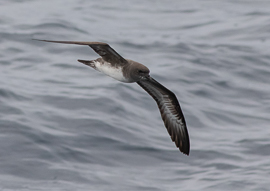 Trindade Petrel
photo
© John Gluth
Trindade Petrel
photo
© John Gluth
(click photo to enlarge)
Attracted to the chum slick on this SeeLife Paulagics trip out of Brooklyn, a light morph Trindade petrel remained for several minutes, allowing for stunning views, great photos, and the opportunity to safely rule out other Pterodroma species. Just the second documented record for New York State, this spectacular highlight was nevertheless to some extent anticipated, based on the species’ increasingly frequent detection in the Gulf Stream waters off Cape Hatteras, North Carolina, over the past 30 years. In contrast, New York State’s only prior record, which was also the first for North America, made little sense at the time. Found in a farm field in Tompkins Co. after the Hurricane of 1933 (Bull 1974), this record seemed for decades almost as outlandish as the enigmatic Mottled Petrel from Livingston County in April 1880 (Bull 1974), or the still-unresolved Hawk Mountain Pterodroma of 3 Oct 1959 (Carboneras et al. 2020). But vastly improved offshore coverage has revolutionized our understanding of one species after another, such that the once almost completely unknown Black-capped Petrel is now expected on carefully planned New York pelagics, and future occurrences of Trindade Petrels here are considered tantalizingly likely.
Brown Booby (Sula leucogaster)
2018-34-A One, Pelagic, Suffolk, 30 Jul (Charles A. Witek III). eBird 30 Jul
This Brown Booby was seen as it flew past a shark-fishing boat by the captain, about ten miles off the south shore of Long Island. Reports of this species have clearly increased in these more northern realms in recent years.
Anhinga (Anhinga anhinga)
2018-33-A/C One, Morningside Park, Sullivan, 23, 29 Jul (Richard Guthrie, John H. Haas, Kenneth M. McDermott, ph R. Guthrie, J. Haas). eBird 23, 29 Jul
John Haas was kayaking on Morningside Lake, looking for shorebirds, when he came across what he assumed was a Double-crested Cormorant, which he photographed. Immediately after reviewing his photos, he realized that it was an
Anhinga! Other birders were able to see this mega-rarity the same day but not afterwards, until Haas himself found it again. In this latter observation the bird was in flight, gaining altitude as it circled over the lake. It was never seen again. This is only the fourth record reviewed and accepted by NYSARC.
Roseate Spoonbill (Platalea ajaja)
2018-35-A One, Wallkill River NWR, Orange, 3 Aug (Kenneth M. McDermott). eBird 29 Jul, 2, 3, 5 Aug
Most sightings of this bird were on the New Jersey side of the wildlife refuge. On a few occasions, however, it was seen on the New York side, including one sighting where it was photographed over Oil City Road (eBird Mar 2021). The total range of dates that the spoonbill was reported was 22 Jul to 6 Aug, with dates that it was found on the New York side shown above (eBird Mar 2021). This is only the second record in the state, with the first occurring on 20 Aug 1992. Prior to 2018 the New York record appears to have been the most northerly of the records shown in eBird. In 2018 there was a remarkable incursion of this species northward. In addition to New York, records in 2018 came from the following states, several with multiple locations: Maine, Connecticut, Pennsylvania, New Jersey, Delaware, Maryland, Virginia, West Virginia, Ohio, Indiana, Illinois, Missouri, Iowa, and Minnesota (eBird Mar 2021).
Swallow-tailed Kite (Elanoides forficatus)
2018-17-A One, East Northport, Suffolk, 28 Apr (Dennis Nowak)
2018-19-A One, Derby Hill Bird Obs., Oswego, 12 May (Joseph Brin). eBird 12 May Both of these records involved birds flying over. The Northport bird was viewed by Dennis Nowak as it circled overhead briefly. The Derby Hill bird was seen by several people at this renowned hawkwatch, first spotted by Joe Brin. Records of this species have been increasing in the northeast, including many, like these two records, that would be classified as a “spring overshoot”, that is, a species that was spurred to migrate northward in spring but continued beyond the normal range of its breeding grounds.
Mississippi Kite (Ictinia mississippiensis)
2018-18-A One, Stony Point, Rockland, 5 May (Alan Wells, ph A. Wells). eBird 5 May 2018-21-A One, Hempstead Lake State Park, Nassau, 9 May (Rich Kelly, ph Sheila Meehan). eBird 9 May
2018-24-A One, Hempstead Lake State Park, Nassau, 28 May (Tim Healy). eBird 28 May All three of these records involved birds flying over during May. Two were supported by excellent photographs. Although it is possible that the two records from Hempstead Lake involved the same bird, that does not seem very likely given the nearly three week separation of sightings at a heavily birded site. As with the Swallow-tailed Kite, most spring sightings of this species are considered overshoots from their more southerly range. It should be noted, however, that as spring overshoot records continue to increase, the possibility of another pair staying to breed in the state increases as well.
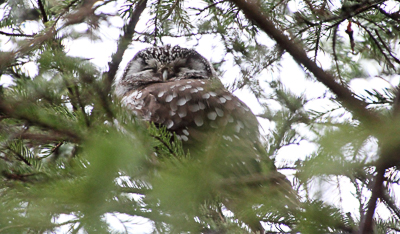 Boreal Owl
photo g
© Dominic Sherony
Boreal Owl
photo g
© Dominic Sherony
(click photo to enlarge)
Boreal Owl (Aegolius funereus)
2018-16-A One, Owl Woods, Braddock Bay WMA, Monroe, 25 Apr (Dominic Sherony, ph D. Sherony). eBird 25 Apr
This Boreal Owl was found by Nick Pusateri and his survey team at the renowned “owl woods” at Braddock Bay. A number of birders were able to see this owl, though it only stayed for one day.
Gyrfalcon (Falco rusticolus)
2018-48-A One, Point Peninsula, Jefferson, 27 Dec (Gerald A. Smith, ph G. Smith)
2018-50-A One, West Chazy, Clinton, 24 Dec (Derek H. Rogers, ph D. Rogers)
Seeing a Gyrfalcon is a thrilling experience, even for the most experienced birders. Veteran birder and hawk-watcher, the late Gerry Smith, had the rare opportunity to study an apparent adult gray-morph bird at length at Point Peninsula in Jefferson County, even hearing the bird call in response to a Northern Harrier flying overhead which dropped its talons. Along the shore of Lake Champlain, Derek Rogers, another veteran birder who has extensive experience with Peregrine Falcons, immediate knew he had something different when he saw this large long-tailed falcon flying towards him. A brief look in binoculars convinced him that he was looking at a white-morph Gyrfalcon. Hurriedly, he jumped out of his vehicle and managed a few photos of the falcon, providing very helpful supplementary documentation. The photos show the underside of the body and wings as it is flying away and it is obvious that the bird is a very pale large falcon. Rogers indicated that less than a half-mile from his sighting and two days later, a perched white-morph Gyrfalcon was photographed by Tara Fuller, almost certainly the same bird.
Ash-throated Flycatcher (Myiarchus cinerascens)
2018-54-A One, Heckscher State Park, Suffolk, 31 Oct (Shaibal S. Mitra, ph S. Mitra). eBird 31 Oct-1 Nov
Joan Quinlan found this Ash-throated Flycatcher which lingered for only two days at Heckscher SP. A fairly reliable if very scarce annual migrant on the coast, this species is still quite rare, and deserves special scrutiny to rule out other even rarer Myiarchus species.
Gray Kingbird (Tyrannus dominicensis)
2018-44-A/B One, Jones Beach State Park, Nassau, 10 Nov (Peter Reisfeld, Tim Healy, ph P. Reisfeld, T. Healy). eBird 10 Nov
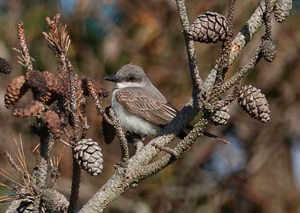 Gray Kingbird
photo
© Peter Reisfeld
Gray Kingbird
photo
© Peter Reisfeld
(click photo to enlarge)
Peter Reisfeld and Bobbi Veltri discovered this one-day-wonder Gray Kingbird at Jones Beach, which a few birders were able to tick off their lists. As with the great majority of records of this southern breeder in New York, the bird was recorded during the fall, likely a “reverse migrant”.
Scissor-tailed Flycatcher (Tyrannus forficatus)
2018-39-A/D One, New Scotland, Albany, 08-14 Oct (Zach Schwartz-Weinstein, Scott Stoner, Kenneth M. McDermott, Thomas Williams, ph Z. Schwartz-Weinstein, S. Stoner,
T. Williams). eBird 8-14, 16-18 Oct
2018-42-A/B One, Montauk, Suffolk, 20-21 Oct (Tim Healy, Patricia Lindsay, ph T. Healy, P. Lindsay). eBird 20-21, 28 Oct
The Albany flycatcher was found by Larry Alden and enjoyed by many over its 11 day stay. The Montauk bird, found
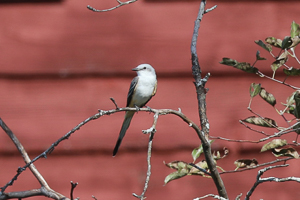 Scissor-tailed Flycatcher
photo
© Zach Schwartz-Weinstein
Scissor-tailed Flycatcher
photo
© Zach Schwartz-Weinstein
(click photo to enlarge)
by Joe Giunta, appeared two days after the upstate bird went missing, and there was some speculation that it might be the same bird. Tim Healy’s report suggests that this would have been quite a feat for the flycatcher to have traveled so far in that time period, and that broad weather patterns and favorable conditions for vagrancy may have been more of a factor, a sentiment that many experienced birders agree with.
Northern Wheatear (Oenanthe oenanthe)
2018-43-A/B One, Heckscher State Park, Suffolk, 28, 30 Oct (Tim Healy, Patricia Lindsay, ph T. Healy, P. Lindsay). eBird 28-30 Oct
This accommodating rarity, found by Lisa Nasta, was not put off by the hordes of birders that descended upon the site as news spread through emails, apps, and phone calls. It stayed faithful to a rather restricted area of the park for three days, hawking insects from low perches along the median and roadway. A highly stereotypical mid- to late-September vagrant in the state, and occasionally found into mid-October, this bird was somewhat notable in its late October appearance.
Golden-crowned Sparrow (Zonotrichiaatricapilla)
2018-49-A/D One, Downsville, Delaware, 30 Dec 2018-5 Jan 2019 (Lance Verderame, John Haas, Kenneth M. McDermott, Tim Healy, ph J. Haas, T. Healy). eBird 30 Dec 2018, 2-6, 8-13, 16, 18, 19, 26 Jan, 10, 17, 24 Feb, 2, 3, 6, 9, 17 Mar, 6 Apr 2019
While scouting for the local Christmas Bird Count, Lance Verderame made the exciting discovery of this immature Golden-crowned Sparrow. He contacted John Haas, who was able to document the bird with photographs. The bird was likely seen by hundreds of birders during the course of its stay, which was for over three months. In an article in The Kingbird, Verderame recounts the discovery of this bird and how he contacted the local residents and police to make them aware ahead of time of the crush of birders that might ensue (Verderame 2019). Verderame’s forethought worked, as the local residents reportedly enjoyed the presence of the birders and, no doubt, the extra income that they injected into the local economy. If only all mega-rarity stories could end so happily.
Green-tailed Towhee (Pipilo chlorurus)
2018-6-A/B One, Township of Montezuma, Cayuga, 13-14 Feb (Kevin McGann, Bill Purcell, ph K. McGann, Donna Carter). eBird 10, 11, 13, 14 Feb
Donna Carter had the pleasure of discovering this Green-tailed Towhee at her feeding station. The bird was seen over a five-day period but only sporadically visited the feeders. Although the bird appeared in eBird when found, the location was not mapped precisely. Despite attempts to find out by local birding leaders, it was not known if the homeowner would be concerned about privacy should the sighting be made known to the statewide birding community. So, at least at first, the sighting was not made broadly public. As a result, relatively few birders had the opportunity to see the towhee. This was the first record of Green-tailed Towhee reviewed and accepted by NYSARC, and only the fourth confirmed record of this western species for New York, the last being in 1977 (Rising 1998). There is also a sight record, an unusual spring record from 1969 seen by multiple observers, which, given credence by Bull (1974), deserves mention.
Western Meadowlark (Sturnella neglecta)
2018-12-A/B One, Savannah, Wayne, 14, 20 Apr 22 May (Joseph Brin, Doug Daniels, ph D. Daniels). eBird 14-30 Apr, 5-7, 10-14, 16, 17, 18-27, 29, 31 May, 4, 8, 9 Jul
Joe Brin heard an unfamiliar song coming from the field in front of him and soon discovered that it was a meadowlark making the vocalization. Checking with his Sibley app, he confirmed that the bird was a Western Meadowlark. The bird was seen in the area, apparently maintaining a territory, into July. However, there was a roughly five week gap in which there were no reports. This could be due to the bird singing less, as many birds do when they get to a certain stage in the breeding cycle. Without the aid of the distinctive song, many birders would have a difficult time identifying the species, though the call note differs from Eastern Meadowlark as well. Unfortunately, it is unknown if this bird had a mate and, if so, whether it was an Eastern or a Western Meadowlark. This is the first record in the state since 2007, when one was found in Chautauqua County (Wilson, et al 2009).
Kirtland’s Warbler (Setophaga kirtlandii)
2018-20-A One, Central Park, New York, 12 May (David J. Ringer, ph D. Ringer). eBird 11-13 May
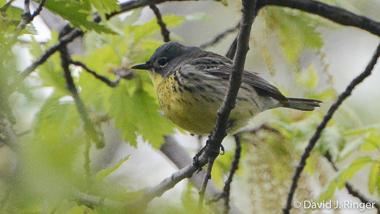 Kirtland's Warbler
photo
© David Ringer
Kirtland's Warbler
photo
© David Ringer
(click photo to enlarge)
New York’s third accepted record for this formerly endangered species was found by Kevin Topping late in the day on 11 May, and delighted hundreds of birders by remaining cooperative for two more days. An adult male, this beauty sang readily as it foraged among the trees, often giving stunning views.
The above record is actually the fourth documented record for the state. A credible report from 18 May 2010, from Wilson, Niagara County, was submitted to NYSARC, but because it was a single observer sighting without a photograph, it precluded acceptance as a first state record. However, it is included in the 2010 report in the Supplemental category, which documents reports that are fully convincing but which fall short of the rigorous requirements for full acceptance onto the state checklist (Wilson, et al. 2012).
Western Tanager (Piranga ludoviciana)
2018-15-A One, Prospect Park, Kings, 16 Apr (Peter Paul, ph P. Paul). eBird 16 Apr Peter Paul happened upon this bird late in the day, and managed a few photos during its two minute stay. This species has shown a pattern of almost annual fall and winter occurrence in the state, occasionally overwintering; however, it is rare
for this heavily birded park, and is only the second record documented in eBird for that location.
Painted Bunting (Passerina ciris)
2018-25-A One, Elmsford, Westchester, 31 Mar, 2 Apr (Julia Rogers, ph Adrian Rogers). eBird 2 Apr
Discovered and photographed by feeder watchers who were unfamiliar with the species, this green-plumaged bird was apparently not seen by any other birders. The homeowners forwarded the description and photos to the Cornell Lab Facebook page and to eBird for confirmation, and submitted this report to NYSARC at the suggestion of Tom Burke, which is much appreciated.
2018 Reports Not Accepted
Barnacle Goose (Branta leucopsis)
2018-8-A One, Town of Fayette, Seneca, 24 Feb
This was an unlucky situation where a birder found this bird at a distance but only had binoculars. He was pretty sure that it was a Barnacle Goose but could not be certain. He raced home for a spotting scope and returned, only to find that the geese had moved on. With the possibility that this could have been an aberrant- plumaged Canada Goose, which are not infrequent, the Committee reluctantly decided not to accept the record.
Mississippi Kite (Ictinia mississippiensis)
2018-38-A One, Clove Lakes Park, Richmond, 17 Sep
This report was submitted by an experienced observer, who saw the bird in flight. Although the description provided was suggestive of this species, there were too many missing details for the Committee to agree to accept the record.
Yellow-bellied x Red-naped Sapsucker (Sphyrapicus varius/nuchalis)
2018-23-A One, Esopus, Ulster, 26 Feb
This was an interesting report, which included photos of a Sphyrapicus woodpecker. The bird can be sexed as a male by its completely red throat with no white on the chin. It appears essentially like a Yellow-bellied Sapsucker (S. varius) but with noticeable red on the nape. In addition, the red throat barely bleeds into the black throat border at the corners. Although the latter might suggest the influence of nuchalis, Committee members felt that it was too minimal. Yellow-bellied does occasionally show red on the nape and since the red intruding into the black throat border was so minimal, the Committee decided that the case for a hybrid combination was not supported strongly enough.
Gyrfalcon (Falco rusticolus)
2018-7-A One, Jones Beach, Nassau, 1 Feb
2018-9-A One, Nanuet, Rockland, 19 Mar
The Jones Beach report was for a bird seen flying past the observer. Although the pointed wings and bulky size that were noted are suggestive of a Gyrfalcon, Committee members were concerned about the missing details, such as the pattern of the underside of the wings, which should be paler on the flight feathers than on a Peregrine Falcon. The Rockland County report was also for a bird seen in flight. The underside was described as white with no barring and the back as uniform and light, white to whitish-gray. If this was a Gyrfalcon this would be the rarest and palest color morph that is seen in the state. Unfortunately, without knowing what the wing shape was, it is even possible that this was a leucistic Red-tailed Hawk, which had been seen in the area in recent years.
LeConte’s Sparrow (Ammospiza leconteii)
2018-40-A One, Albany Pine Bush Preserve, Albany, 5 Oct
This report involved a four minute observation of a sparrow showing buff on the side of the head, throat, and flanks, a clean white belly, and fine dark streaking along the flanks. The upperparts were reported to show dark centers with buff edges. Although this report received some support from Committee members, most felt that the close similarity between some LeConte’s and Nelson’s Sparrows, in addition to the missing details of the crown and nape, were enough for them not to accept a report of such a rare species.
Brewer’s Blackbird (Euphagus cyanocephalus)
2018-11-A Four, Vischer Ferry Nature & Historic Preserve, Saratoga, 8 Apr
This submission of three male and one female Brewer’s Blackbirds along the edge of the Mohawk River seemed better for the similar Rusty Blackbird than Brewer’s, to most Committee members. Although the iridescent green tint noted might suggest Brewer’s, Rusty can also show this in some lights. Importantly, the female was noted to be all gray, which is better for Rusty, as female Brewer’s are more brownish gray. A distinctive character to help separate females of the two species is the eye color, normally dark in Brewer’s and light in Rusty. Unfortunately, the eye color was not noted.
MacGillivray’s Warbler (Geothlypis tolmiei)
2018-27-A One, Ulster Park, Ulster, 15 May
This was an intriguing report from a lone observer. The circumstances of the observation, as well as the habitat, were well described and the observer also included a colored drawing of the bird, placed on a photograph of the bush that the bird was perched in. However, it was not stated whether the sketch was from memory of what was observed or simply taken from a field guide. For such a remarkably rare species, reviewers felt that more was needed. The observer initially thought that she was hearing and seeing a Mourning Warbler and only considered MacGillivray’s Warbler, of which she was previously unaware, after the sighting. The call that was heard seems to be what made her suspect that this was not a Mourning Warbler. It is assumed that she meant song, rather than call. However, the song and its difference from that of a Mourning Warbler were not described. Although some Committee members felt that the sighting could be correct, none felt that the evidence rose to the level of acceptance.
1984 Report Not Accepted
Eurasian Blackbird (Turdus merula)
1984-52-A Six to ten, Goat Island, Niagara, 5 Aug
This was a very unusual report, submitted about 34 years after the sighting, from someone visiting Niagara Falls on his honeymoon. There was no photographic evidence, just a description of what was observed. The report implies that the identification of these six to ten males was made two years after the fact, when he observed his life Eurasian Blackbirds in England. Several aspects of this report would be extremely unusual for this species, especially the occurrence of six to ten individuals, the location, well away from the East coast, and the time of year. Even the possibility that these birds were escapes is highly improbable. The observer wrote that he was stunned to see American Robins that were all black. He also noted a yellow-orange bill and a light-colored eyering. While this description is clearly consistent with the species, documentation for such an extraordinary sighting would need to be much stronger to be accepted. A glance at eBird shows only two records in all of North America (eBird March 2021).
CONTRIBUTORS
Anneliese Arnold, Joseph Brin, Donna Carter, Chris Cording, Doug Daniels, Joseph DiCostanzo, Howard Fischer, Virginia Fratti, Kate Fuller, Arie Gilbert, John Gluth, Richard Guthrie, John H. Haas, Tim Healy, Thomas O’Dell Jervey, Geoffrey Jones, Rich Kelly, Ted Keyel, Patricia Lindsay, Joshua Malbin, Annie Mardiney, Kenneth M. McDermott, Kevin McGann, Sheila Meehan, Shaibal S. Mitra, Steve Nanz, Dennis Nowak, Joseph O’Sullivan, Peter Paul, Bill Purcell, Peter Reisfeld, David J. Ringer, Adrian Rogers, Julia Rogers, Derek H. Rogers, Charlie Rouse, Zach Schwartz-Weinstein, Dominic Sherony, Sean Sime, Gerald A. Smith, Scott Stoner, Paul Sweet, Scott L. Varney, Lance Verderame, Rufus Wareham, Alan Wells, Thomas Williams, Joseph Wing, Charles A. Witek III, Michael Yuan, Robert P. Yunick, Eric Zawatski.
Submitted on behalf of the New York State Avian Records Committee:
Willie D’Anna (Chair), Gary Chapin (Secretary), Shawn Billerman, Thomas W. Burke,
Doug Gochfeld, Jay McGowan, Patricia Lindsay, Derek H. Rogers
LITERATURE CITED
Amos, E. J. R. 1991. A guide to the birds of Bermuda. Corncrake, Warwick, Bermuda.
Brock, R. W. 1998. Slaty-backed Gull. In Bull’s Birds of New York State. E. Levine, Ed. Cornell University Press, Ithaca, NY. p. 288-289.
Buckley, P.A., E.B. Massiah, M. B. Hutt, F. G. Buckley and H. F Hutt. 2009. The birds of Barbados. The Hanway Press, London. p. 131.
Bull, J. 1974. South Trinidad or Herald Petrel (Pterodroma arminjoniana); Scaled or Mottled Petrel (Pterodroma inexpectata). In Birds of New York State. Doubleday, Garden City, NY. p. 62.
Green-tailed Towhee (Pipilo chlorura). In Birds of New York State. Doubleday, Garden City, NY. p. 571.
Burke, T.W. 1991. Photographs of New York State rarities 52: Wood Sandpiper at Marshlands Conservancy. The Kingbird Vol. 41(2): 71-72.
Burke, T.W. 1998. Wood Sandpiper (Tringa glareola). In Bull’s Birds of New York State. E. Levine, Ed. Cornell University Press. p. 238.
Carboneras, C., F. Jutglar, G. M. Kirwan, and C. J. Sharpe. 2020. Trindade Petrel (Pterodroma arminjoniana), version 1.0. In Birds of the World (J. del Hoyo, A. Elliott, J. Sargatal, D. A. Christie, and E. de Juana, Eds). Cornell Lab of Ornithology, Ithaca, NY, USA. https://doi.org/10.2173/bow.tripet1.01. Accessed December 2021.
Chesser, R. T., S. M. Billerman, K. J. Burns, C. Cicero, J. L. Dunn, B. E. Hernández-Baños, A. W. Kratter, I. J. Lovette, N. A. Mason, P. C. Rasmussen, J. V. Remsen, Jr., D. F. Stotz, and K. Winker. 2021. Check-list of North American Birds (online). American Ornithological Society. http://checklist.aou.org/taxa
D’Anna, W., G. Chapin, S. Billerman, T. W. Burke, D. Gochfeld, J. Pawlicki, P. Lindsay, D. Rogers, J. McGowan. 2021. Report of the New York State Avian Records Committee for 2017. The Kingbird Vol. 71(2): 102-120.
Davis, A., S. S. Mitra, R. O. Paxton, F. Rohrbacher. 2021. Fall 2020: Hudson-Delaware report. In North American Birds. https://wp.me/p8iY2g-aDB. Accessed November 2022.
Dziadosz, V. M. 1980. Specimen record of the Wood Sandpiper for the contiguous United States. In American Birds Vol. 34, p. 231.
eBird. 2022. An online database of bird sightings created by Cornell Lab of Ornithology, Ithaca, NY, and launched in 2002. https://ebird.org/home
Ellison, W. G., N. L. Martin. 2013. New England report. August through November 2011. In North American Birds 67(1): 35-43.
Mactavash, B. 1999. Atlantic Provinces Region report. August through November 1998. In North American Birds 53(1): 25-27.
Mitra, S. S. 2009. Regular inshore occurrence of non-breeding Arctic Terns (Sterna paradisaea) during summer on Long Island, New York. The Kingbird Vol. (1): 2-11.
Mitra, S. S. and P. J. Lindsay. 2018. Region 10 – Marine. The Kingbird Vol. 68(4): 353.
Rising, G. 1998. Green-tailed Towhee (Pipilo chlorurus). In Bull’s Birds of New York State. E. Levine, ed. Cornell University Press, Ithaca, NY. p. 501.
Veit, R., R. O. Paxton, and F. Rohrbacher. 2008. Hudson Delaware report. March through May 2008. In North American Birds 62(3): 381-384.
Verderame, L. 2019. A Golden-crowned Sparrow (Zonotrichia atricapilla) in Delaware County: New York’s Fourth. The Kingbird Vol. 69(3): 206-208.
Wilson, A., J. Skelly, J. S. Bolsinger, T. W. Burke, W. D’Anna, A. Guthrie, S. S. Mitra, and D. Sherony. 2009. Report of the New York State Avian Records Committee for 2007. The Kingbird Vol. 59(4): 324.
Wilson, A., J. Skelly, W. D’Anna, J. Bolsinger, T. W. Burke, A. Guthrie, T. B. Johnson, and D. Sherony. 2012. Report of the New York Avian Records Committee for 2010. The Kingbird Vol. 62(2): 117-119. |

